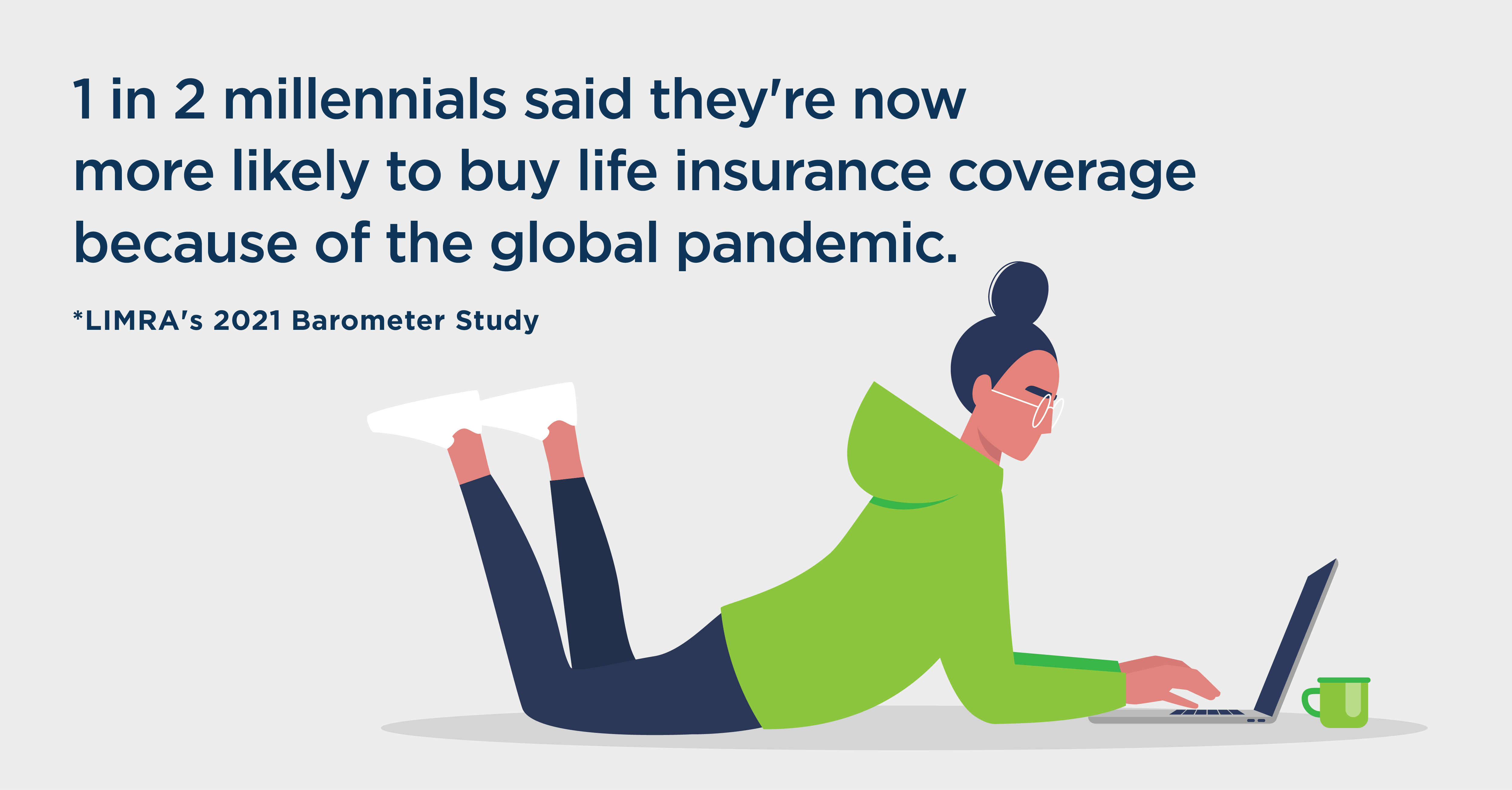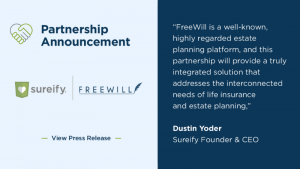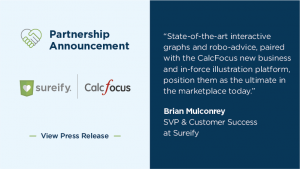The life insurers we work with at Sureify are seeing a trend among millennials—they‘re recognizing the need for life insurance more than ever… and they’re taking the plunge!
There are a lot of good reasons these younger buyers (in this case, those born between 1981 and 1996) are buying life insurance for their loved ones. They are at a point in their lives where it’s likely that, for many applicants, rates will be affordable and the underwriting process will be relatively painless (even instantaneous). And even if it took COVID-19 to bring us to this point, this positive buying trend represents good news for the industry—it signifies that our message is getting through.
LIMRA’s 2021 Barometer Study found that nearly half of millennials surveyed (45%) said they’re now more likely to buy life insurance coverage because of the global pandemic. That amount far exceeds baby boomers and Gen X individuals who would do the same, at 15% and 31%, respectively
As we think about what this means to the industry and to software providers (like Sureify), I spent some time researching. There have been other periods of difficulty in the past—why is this generation in this time reacting differently? Here are a few of the factors that I believe have turned these young buyers on to the importance of life insurance:
1. Covid 19
Many millennials have lived through HIV/AIDS, SARS-CoV, H1N1, and even an Ebola outbreak in 2013. But this global pandemic put millennials in a place where most had never been before: face to face with their own mortality. COVID, and the associated mental health crisis that arose from it, changed their perspective.
According to a recent article in Insurance News Net, OneAmerica Insurance, a leading group life and health insurer, reported that death claims in Q4 of 2021 among insureds ages 18-64 were 40% higher than the same period in 2020. “We’re seeing right now the highest death rates we have ever seen in the history of this business,” J. Scott Davison, the CEO of OneAmerica, said during an online event in January.
The higher-than-average death trend can also be found among individual life insurers, although is tempered by different underwriting standards. “We’re not experiencing that type of mortality,” said Matt Berman, President of Foresters’ U.S. life insurance division, regarding OneAmerica Insurance’s death rates (although he declined to divulge specific numbers). “But I will say that we have certainly experienced an uptick in mortality.”
The uncertainty of life during COVID has opened a lot of eyes, especially those of millennials, who have been made hyper-aware of the necessity of protecting their loved ones. Among this age group, two-thirds of those surveyed say they have dependents under 18 living in their households, and 43% are more concerned than other generations about leaving their dependents in a difficult financial situation or burdening them with expenses if they should die.
2. Technology
Millennials are, for the most part, digital natives. They were born into a world in which the excitement of new technology was just beginning. During the lifetimes of the oldest millennials (who have recently turned 40!), the Internet became a “thing,” smart phones were born, mall arcades were replaced by personal video game devices. From a tech standpoint, all of these represented new channels of connection—and new channels of opportunity.
With the increasing dissemination of real-time information through channels unimaginable 25 years ago, the word is out—life insurance, a valuable financial planning tool, is necessary, affordable, and easy to get. This has translated into sales. According to LIMRA, in the first six months of 2021, the total number of policies sold increased 8% compared with prior year results. This is the highest policy sales growth recorded since 1983.
3. Increased interest in financial planning
A recent Fortune article reported that “Today’s millennials and Gen Z have more economic power than any generation that preceded them. They are earning more, saving more, and investing earlier and at a higher rate than previous generations. For millennials, 31% started investing before age 21, compared to only 9% of baby boomers and 14% of Gen X.”
From wealthprofessional.ca: “Millennials’ money values are shifting, and they’re more interested in developing financial plans. But, while more want to save, the pandemic and inflation are making it difficult. As a group, they are caught between traditional financial values and a contemporary lifestyle that is vastly different from that of the generation before them.” Could this new focus on finances and the future be the result of the digital wave that so many traditional companies are now riding? Platforms like Mint are making it easier than ever to manage money online, and that is an incredibly attractive proposition to someone who expects the ease of experience that is indicative of digital-first platforms.
As traditional life insurers modernize with more intuitive, personalized CX, accelerated underwriting and enhanced digital communication that match these investment platforms, the perception of life insurance among millennials is beginning to change.
Of course, the modern life insurance agent is still a critical part of the equation for millennials. From a report issued by Boston Consulting Group, “Among millennials who purchased life insurance in the pandemic, more than half used a live adviser, and 30% used both a live adviser and online elements in their purchase.”
This younger cohort is more interested in, and more personally invested in, their financial futures. By incorporating ease of experience, education through multiple channels, and digital tools to help agents thrive, life insurers can take the steps necessary to become an integral part of millennials’ planning process.
4. Inflation
As the world begins to deal with the emerging economic impacts of the COVID pandemic, life insurers have an opportunity to educate and position life insurance as a protective tool to hedge against one of the biggest financial challenges current generations are facing: inflation. These are timely messages millennials need and want to learn more about.
Here’s why: In an article entitled Rising Inflation Viewed As Biggest Threat to Retirement in 2022, the American Society of Pension Professionals and Actuaries says, “All Americans are paying more for food, fuel and utilities than they were a year ago. This has shifted millennials toward a new passion for planning for the future. Millennials are particularly concerned that the rising cost of living will affect their ability to pay for necessities (65%) and save enough for retirement (71%) and short-term goals (70%).
By remaining aware of the implications of inflation, millennials see the importance of maximizing their capital to protect them into the future. Like no other time in recent history, this group of young adults can both feel the effects of inflation and access ideas to mitigate those effects.
And, as millennials become more likely to purchase life insurance, insurers are evolving their offerings to create new products and innovations to meet their needs. That’s great news for first-time applicants who may find a much more painless process and more attractive price point than expected.
5. More awareness + lower ownership of group life insurance
Once upon a time, life insurance was a highly attractive benefit offered by employers—and it was highly-utilized by employees. In 2022, however, that’s not necessarily the case. LIMRA’s 2021 Barometer Study reported that “Among the 52 percent of adult Americans who own some form of life insurance, 48 percent own group/employer-sponsored coverage.” One decade ago, however, “60 percent owned group/employer-sponsored coverage.” That’s a 12 percent decrease over the course of ten years.
But LIMRA also discovered that “Six in ten employees say life insurance is an important or very important benefit, regardless of whether they currently have it available to them through their employer.”
While the ownership of employer-sponsored life insurance has declined, employees continue to recognize the value of life insurance. In fact, half of millennials say their families would face financial hardship should a wage earner die unexpectedly. The result of this environment where fewer employees have life insurance benefits through their job? From a Kiplinger report: More than 50% of those who have life insurance purchased it individually.
Millennials are a viable market
All of these factors are converging to make the millennial market an attractive group for life insurers to focus on:
- The opportunity is there, according to many sources. Only 10% of millennials say they have enough life insurance in place to cover needs if they should die, putting their family members at risk.
- Millennials are under-insured. Even for those millennials who have life insurance, the average coverage is about $100,000, enough to cover only 22% of their self-reported coverage needs of $452,000. That’s a shortfall of $352,000.
What insurers should do
1. Enhance the customer experience to match the best user experiences in the market
Millennials are comfortable (and often prefer) researching products and making purchases online—whether they’re buying their weekly groceries or a new car. Prior to the pandemic, life insurers and agents were already making enhancements to digital tools to make it easier for consumers to research and purchase life insurance online, but the pandemic accelerated those improvements.
Since most policies are purchased from agents, equip producers with digital tools that make the entire experience simple for the client and the agent—including simple, navigable UX and tools that make it easier to sell and service policies. And, offer a seamless omnichannel solution, giving customers the option to complete the application online (via D2C, agent or even embedded channels) or over the phone if they choose. This is critical when tapping the millennial market.
2. Look for untapped or lesser tapped markets
Speaking of tapping markets… digitalization has greatly evolved the interactions between carrier, agent and policyholder.
In the past, an annual bill from the carrier or a yearly birthday greeting from an agent was considered a sufficient check-in. Now, millennials expect—in fact, demand—an ongoing relationship with brands from whom they purchase a product or service. But this shift can be beneficial for the carrier and agent, too. Carriers can offer new products that fit millennials needs as they progress through various stages of life. To capitalize effectively, create a customer experience and interactive engagement strategy that focuses on deepening connection, building brand loyalty and increasing retention so that trust is well-established when it’s time to make new product recommendations.
Additionally, The Internet of Things (IOT) is now making it possible to offer life insurance recommendations to those purchasing other products online through embedded insurance capabilities. And customers are ready for these possibilities. Accenture found that “Customers are increasingly willing to consider insurance purchases while shopping for other needs. Some 40 percent would consider buying insurance from a car dealer, for instance, while 30 percent might choose a retailer or supermarket, and 29 percent would consider online service providers.” This applies across all insurance products, including auto, home and life.
Finally, digitalization is also providing carriers new markets via connection with wearables. This technology now enables life insurers to create an environment of “continual underwriting” versus the conventional point-in-time underwriting, with innovative products and tailored offers emerging to reflect shifting customer behaviors. Our stats show that upwards of 80% of life insurance engagement app users connect at least one device.
Here’s real customer feedback that shows the power of creating a caring relationship with policyholders through wearable devices: “I have earned a number of rewards, but more importantly, the app engaged me to exercise and walk, and to get up and walk the extra steps and flights to earn points. It was invaluable during the height of the pandemic in 2020. It was nice to learn about ways to a healthier lifestyle. I always enjoyed the videos and quizzes and surveys. I liked to see how my responses matched up with others across the country.
Millennials expect unique products and flexibility from insurers and will gravitate to those who can provide a customized experience like the examples I have listed above.
3. Empower agents (in person and call center)
Despite millennials’ turn toward digital experiences, the need for expert advice—i.e., agents—is more critical than ever. In a recent study conducted by Aite-Novarica Group and Sureify, it was found that “Between January 2020 and August 2021, only 21% of life insurance buyers surveyed… used a traditional paper-based application. While 23% bought their policy directly through a website, a large majority—53%—used an agent-assisted online process.”
So, when millennials are ready to buy, make sure that agents are able to offer a flawless, error-free user experience with paperless, flexible digital application platforms. And as this generation has the expectation that they will be able to buy in-person, over the phone or online, ensure that an omnichannel experience is available when the “moment of truth” happens.
As we propel ourselves into what seem to be the waning days of the pandemic (and hopefully a post-pandemic world), the need for life insurance is only going to increase for this up-and-coming generation. That’s why it’s imperative that our industry continues to look for new and innovative ways to position itself positively with millennial buyers.





